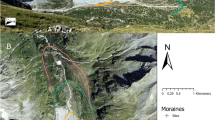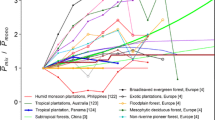Abstract
Plant–plant interactions play a key role in regulating the composition of communities. The outcome of interactions is the net effect of both positive and negative interactions. Positive interactions (facilitation) are defined as non-trophic interactions that increase the average individual fitness of at least one of the species involved. The study area was the Salinas and Aguada Blanca National Reserve, in the southern Peruvian Andes, composed of Festuca orthophylla grassland (dry Puna). The research goals were to ascertain whether spatial interactions act in this plant community, in order to determine whether beneficiary species have species–specific spatial associations. Our findings indicate that the most important nurses were the tall tussock species. A direct correlation was observed between the dimension of the F. orthophylla tussocks and the number of beneficiary species. Twelve species were closely associated with nurse species; five occurred in relation with nurse plants but without any preference for one of them; four species grew both isolated and in relationship with nurse plants and six species mostly grew isolated on bare soil. Because of the impact of grazers, some plants cannot grow on open ground; in fact, the species most in need of spatial interactions are those without avoidance strategies and/or with broad leaves. F. orthophylla is the core of a clumped spatial pattern of vegetation. The importance of spatial interactions for biodiversity conservation seems to be closely related to environmental amelioration and to grazer activity because plants of low palatability often serve as biotic refuges for palatable plants.



Similar content being viewed by others
References
Armas C, Pugnaire FI (2005) Plant interactions govern population dynamics in a semi-arid plant community. J Ecol 93:978–989
Arredondo-Núñez A, Badano EI, Bustamante RO (2009) How beneficial are nurse plants? A meta-analysis of the effects of cushion plants on high-Andean plant communities. Community Ecol 10(1):1–6
Arroyo MTK, Cavieres LA, Peñaloza A, Arroyo-Kalin MA (2003) Positive associations between the cushion plant Azorella monantha (Apiaceae) and alpine plant species in the Chilean Patagonian Andes. Plant Ecol 169:121–129
Badano EI, Jones CG, Cavieres LA, Wright JP (2006) Assessing impacts of ecosystem engineers on community organization: a general approach illustrated by effects of a high-Andean cushion plant. Oikos 115:369–385
Badano EI, Villarroel E, Bustamante RO, Marquet PO, Cavieres LA (2007) Ecosystem engineering facilitates invasions by exotic plants in high-Andean ecosystems. J Ecol 95:682–688
Baumeister D, Callaway RM (2006) Facilitative effects of Pinus flexilis during succession: a hierarchy of mechanisms benefits other plant species. Ecology 87:1816–1830
Bertness MD, Callaway R (1994) Positive interactions in communities. Trends Ecol Evol 9:191–193
Brack Egg A, Mendiola C (2004) Ecología del Perù. Quebecor world Peru S.A, Lima
Brako L, Zarucchi JL (1993) Catalogue of the flowering plants and gymnosperms of Peru, Monographs in Systematic Botany, vol 45. Missouri Botanical Garden, St Louis
Brooker RW (2006) Plant-plant interactions and environmental change. New Phytol 171:271–284
Bruno JF, Stachowicz JJ, Bertness MD (2003) Inclusion of facilitation into ecological theory. Trends Ecol Evol 18(3):119–125
Cabrera AL (1968) Ecologia vegetal de la Puna. Colloquium Geogr 9:91–116
Callaway RM (1995) Positive interactions among plants. Bot Rev 61:306–349
Callaway RM (2007) Positive interactions and interdependence in plant communities. Springer, Berlin
Callaway RM, Walker LR (1997) Competition and facilitation: a synthetic approach to interactions in plant communities. Ecology 78:1958–1965
Callaway RM, Kikvidze Z, Kikodze D (2000) Facilitation by unpalatable weeds may conserve plant diversity in overgrazed meadows in the Caucasus Mountains. Oikos 89:275–282
Callaway RM, Brooker RW, Choler P, Kikvidze Z, Lortie CJ, Michalet R, Paolini L, Pugnaire FI, Newingham B, Aschehoug ET, Armas C, Kikodze D, Cook BJ (2002) Positive interactions among alpine plants increase with stress. Nature 417:844–848
Cavieres LA, Badano EI (2009) Do facilitative interactions increase species richness at the entire community level? J Ecol 97:1181–1191
Cavieres LA, Badano EI, Sierra-Almeida A, Gómez-González S, Molina-Montenegro MA (2006) Positive interactions between alpine plant species and the nurse cushion plant Laretia acaulis do not increase with elevation in the Andes of central Chile. New Phytol 169:59–69
Cavieres LA, Badano EI, Sierra-Almeida A, Molina-Montenegro MA (2007) Microclimatic modifications of cushion plants and their consequences for seedling survival of native and non-native plants in the high-Andes of central Chile. Arct Antarc Alp Res 39:229–236
Crofts A, Jefferson RG (1999) The lowland grassland management handbook. English Nature/The Wildlife Trusts, London
Dickie IA, Schnitzer SA, Reich PB, Hobbie SE (2005) Spatially disjunct effects of co-occurring competition and facilitation. Ecol Lett 8:1191–1200
Ellner S, Shmida A (1981) Why are adaptations for long-range seed dispersal rare in desert plants? Oecologia 51:133–144
Flores J, Jurado E (2003) Are nurse-protegé interactions more common among plants from arid environments? J Veg Sci 14:911–916
Franco AC, Nobel PS (1989) Effect of nurse plants on the microhabitat and growth of cacti. J Ecol 77:870–886
Fuentes ER, Otaiza RD, Alliende MC, Hoffmann A, Poiani A (1984) Shrub clumps of the Chilean matorral vegetation: structure and possible maintenance mechanisms. Oecologia 62:405–411
García E, Beck SG (2006) Puna. Botánica Económica de los Andes Centrales. Universidad Mayor de San Andrés, La Paz, pp 51–76
Genin D, Tichit M (1997) Degradability of Andean range forages in llamas and sheep. J Range Manage 50(4):381–385
Genin D, Villca Z, Abasto P (1994) Diet selection and utilization by llama and sheep in a high altitude-arid rangeland of Bolivia. J Range Manage 47:245–248
Haase P, Pugnaire FI, Clark SC, Incoll LD (1996) Spatial patterns in a two-tiered semiarid shrubland in southeastern Spain. J Veg Sci 7:527–534
Hirzel A, Guisan A (2002) Which is the optimal sampling strategy for habitat suitability modelling. Ecol Model 157:331–341
Holzapfel C, Mahall BE (1999) Bidirectional facilitation and interference between shrubs and annuals in the Mojave Desert. Ecology 80:1747–1761
Hunter AF, Aarssen LW (1988) Plants helping plants. Bioscience 38:34–40
Kikvidze Z, Pugnaire FM, Brooker RW, Choler P, Lortie J, Michalet R, Callaway R (2005) Linking patterns and processes in alpine plant communities: a global study. Ecology 86(6):1395–1400
Kikvidze Z, Michalet R, Brooker RW, Cavieres LA, Lortie CJ, Pugnaire FI, Callaway RM (2011) Climatic drivers of plant–plant interactions and diversity in alpine communities. Alp Bot 121:63–70
Körner C (2003) Alpine plant life: functional plant ecology of high mountain ecosystems, 2nd edn. Springer, Berlin
McAuliffe JR (1988) Markovian dynamics of simple and complex desert plant communities. Am Nat 131:459–490
McCune B, Grace JB (2002) Analysis of Ecological Communities. MjM Software Design, Gleneden Beach
McCune B, Mefford MJ (2006) PC-ORD. Multivariate analysis of ecological data. Version 5. MjM Software Design, Gleneden Beach
McIntire EJB, Fajardo A (2009) Beyond description: the active and effective way to infer processes from spatial patterns. Ecology 90(1):46–56
Milchunas DG, Noy-Meir I (2002) Grazing refuges external avoidance of herbivory and plant diversity. Oikos 99:113–130
Molina-Montenegro MA, Badano EI, Inostroza P, Cavieres LA (2005) Intercambio gaseoso en dos especies de plantas alto andinas de Chile central: efecto de la asociación a plantas en cojín. Ecología Austral 15:49–58
Monteiro JAF, Hiltbrunner E, Körner C (2011) Functional morphology and microclimate of Festuca orthophylla, the dominant tall tussock grass in the Andean Altiplano. Flora 206:387–396
Montenegro B, Zúñiga S, Zeballos H (2010) Climatología de la Reserva Nacional Salinas y Aguada Blanca, suroeste del Perú. In: Zeballos H, Ochoa JA, López E (eds) Diversidad biológica de la Reserva Nacional de Salinas y Aguada Blanca. Desco, Profonanpe, Sernanp. Lima, pp 261–273
Moro MJ, Pugnaire FI, Haase P, Puigdefábregas J (1997) Effect of the canopy of Retama sphaerocarpa on its understory in a semiarid environment. Funct Ecol 11:425–431
Oesterheld M, Oyarzábal M (2004) Grass-to-grass protection from grazing in a semi-arid steppe. Facilitation, competition, and mass effect. Oikos 107:576–582
Padilla FM, Pugnaire FI (2006) The role of nurse plants in the restoration of degraded environments. Front Ecol Environ 4(4):196–202
Patty L, Halloy SRP, Hiltbrunner E, Körner C (2010) Biomass allocation in herbaceous plants under grazing impact in the high semi-arid Andes. Flora 205:695–703
Podani J (2001) Syn-tax 2000 Computer program for data analysis in ecology and systematics. Scientia, Budapest
Pugnaire FI, Luque MT (2001) Changes in plant interactions along a gradient of environmental stress. Oikos 93:42–49
Pugnaire FI, Haase P, Puigdefábregas J (1996) Facilitation between higher plant species in a semiarid environment. Ecology 77:1420–1426
Rebollo S, Milchunas DG, Noy-Meir I, Chapman PL (2002) The role of a spiny plant refuge in structuring grazed shortgrass steppe plant communities. Oikos 98:53–64
Rivas-Martínez S, Tovar O (1982) Vegetatio Andinae, I. Datos sobre las comunidades vegetales altoandinas de los Andes Centrales del Perú. Lazaroa 4:167–187
Schenk HJ, Mahall BE (2002) Positive and negative plant interactions contribute to a north–south-patterned association between two desert shrub species. Oecologia 132:402–410
Sebastià MT, de Bello F, Puig L, Taull M (2008) Grazing as a factor structuring grasslands in the Pyrenees. Appl Veg Sci 11:215–222
SPSS Inc (2005) SPSS for Windows. Version 13.0. Chicago, Illinois
Talavera C, Ortega A, Villegas L (2010) Flora y vegetación de la Reserva Nacional de Salinas y Aguada Blanca, Perú. In: Zeballos H, Ochoa JA, López E (eds) Diversidad biológica de la Reserva Nacional de Salinas y Aguada Blanca. Desco, Profonanpe, Sernanp, Lima, pp 89–104
Tewksbury JJ, Lloyd JD (2001) Positive interactions under nurse-plants: spatial scale, stress gradients and benefactor size. Oecologia 127:425–434
Tewksbury JJ, Nabhan GP, Norman D, Suzan H, Tuxill J, Donovan J (1999) In situ conservation of wild chiles and their biotic associates. Conserv Biol 13:98–107
Tirado R, Pugnaire FI (2003) Shrub spatial aggregation and consequences for reproductive success. Oecologia 136:296–301
Valiente-Banuet A, Ezcurra E (1991) Shade as a cause of the association between the cactus Neobuxbaumia tetetzo and the nurse plant Mimosa luisana in the Tehuacan Valley, Mexico. J Ecol 79:961–971
Valiente-Banuet A, Verdú M (2007) Facilitation can increase the phylogenetic diversity of plant communities. Ecol Lett 10:1029–1036
Valiente-Banuet A, Vite F, Zavala-Hurtado JA (1991) Interaction between the cactus Neobuxbaumia tetetzo and the nurse shrub Mimosa luisana. J Veg Sci 2:11–14
Vetaas OR (1992) Micro-site effects of trees and shrubs in dry savannas. J Veg Sci 3:337–344
Walker LR (1994) Effects of fern thickets on woodland development on landslides in Puerto Rico. J Veg Sci 5:525–532
Yager K, Resnikowski H, Halloy S (2008) Grazing and climatic variability in Sajama national park, Bolivia. Pirineos 163:97–109
Zeballos H, Ochoa JA, Cornejo A (2010) La Reserva Nacional de Salinas y Aguada Blanca, una muestra representativa de puna seca de América del Sur. In: Zeballos H, Ochoa JA, López E (eds) Diversidad biológica de la Reserva Nacional de Salinas y Aguada Blanca. Desco, Profonanpe, Sernanp, Lima, pp 15–29
Acknowledgments
This study was supported by a grant of the Peruvian Trust Fund for National Parks and Protected Areas (PROFONANPE), Funds for Applied Research (F.A.R.) of the Italian Ministry of Education, University, and Research (M.I.U.R.) assigned to Prof. Andrea Catorci, and a grant of the School of Advanced Studies PhD Course in Environmental Sciences and Public Health, University of Camerino (Italy) assigned to Dr. Sabrina Cesaretti. The authors would like to thank the Peruvian National Service of Natural Protected Areas (SERNANP) for the authorization to investigate in the Salinas and Aguada Blanca National Reserve; Dr. John Machaca (Desco) for logistic support and Ms. Sheila Beatty for the English revision of the manuscript.
Author information
Authors and Affiliations
Corresponding author
Rights and permissions
About this article
Cite this article
Catorci, A., Cesaretti, S., Velasquez, J.L. et al. Plant–plant spatial interactions in the dry Puna (southern Peruvian Andes). Alp Botany 121, 113–121 (2011). https://doi.org/10.1007/s00035-011-0097-1
Received:
Revised:
Accepted:
Published:
Issue Date:
DOI: https://doi.org/10.1007/s00035-011-0097-1




